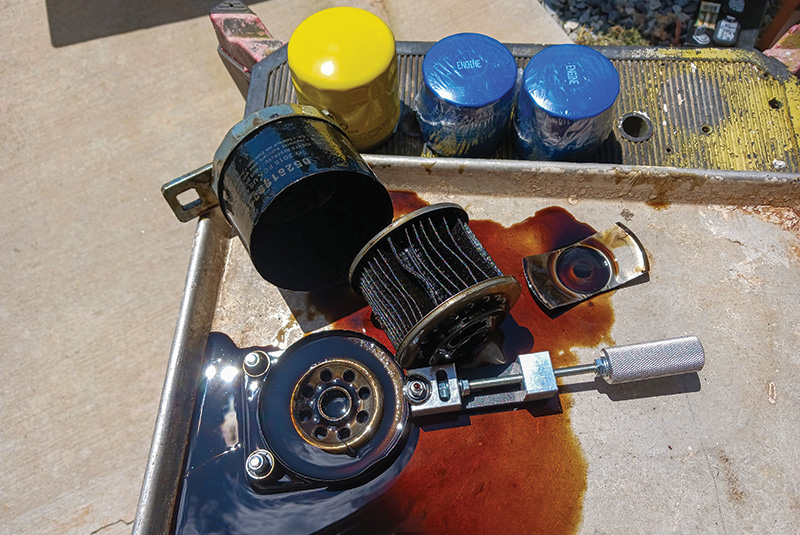
Opening a used oil filter tells the story of an engine’s condition and results of oil formulated to clean while lubricating. This cheap ($18) filter cutter does not adjust to cut the small blue filters used by a Subaru but works with the yellow small-engine filter and full-sized automotive filter. The process is messy but is made easier by using a filter gripper and working on a reject baking tray. Photos by Scott Nesbitt
Recent developments in engine oil create new ways to examine the inner workings of gasoline and diesel four-stroke engines without performing major surgery — all it takes is a modest change in routine maintenance.
In the last few years, Valvoline Inc. has introduced oils that scrub junk off internal engine parts during the course of normal oil change intervals. In theory, over time, with more oil changes (at shorter intervals), the engine’s piston rings get cleaner, oil consumption goes down, cylinder compression increases, fuel economy and engine power rise, and the engine’s working life extends.
This is a slow cleaning. Engine flush solvents, kerosene or other oil thinners applied before an oil change can release so much sludge the oil system clogs up and stops lubricating. It’s not worth the gamble. Better to spend about $30 for an oil filter cutter that handles filters as small as 1¾-inch diameter. Open and inspect the filter element after 1,000 miles (or 25 hours) to see what, if anything, is coming out of the engine.
I’m a believer after a 60-day test of Valvoline Restore & Protect (R&P) oil for gasoline engines. I’ve yet to try Premium Blue Restore Gen 2, made for diesel engines. These oils cost up to $1 more per quart (in the 5-quart or 4-quart jugs) compared to other full-synthetic oils from Valvoline and other major brands.

Released in early 2024, Valvoline Restore & Protect is gaining advocates who support the claims of its cleaning abilities. This oil for gasoline engines joins the company’s diesel-engine Premium Blue Restore oils developed with Cummins diesel and now in its second generation.
My 1997 Dodge truck, with 150,000 miles on the 5.9-liter (360-cubic-inch) gasoline V8, was blowing gray oil smoke when started cold. Steady highway drives used a quart in about 800 miles. Filter inspection after using R&P revealed nasty little carbon particles, presumably from the piston rings. After 2,000 miles, the start-up smoke is gone. Highway oil use is down about 25%. The same drop in oil use is evident in our 2013 Subaru with 50,000 miles on a factory-recall new short block. I’m planning to change oil every 2,500 to 3,000 miles and cut open the filters to gauge the engine’s internal condition.
There’s a hitch. Restore & Protect only comes in 0W-20, 5W-20 and 5W-30. Those work for the Subaru, but the old Dodge wants 10W-30. I gave the truck 5W-30 at the start of last winter with no issues. But Georgia summer heat calls for heavier oil. I plan to blend 20W-50 Valvoline full synthetic with the R&P to get higher summer viscosity. Here’s hoping.
Multi-weight oils defeat nature by adding viscosity index improvers … “polymeric molecules that are sensitive to temperature. At low temperatures, the molecule chain contracts and does not impact the fluid viscosity. At high temperatures, the chain relaxes and an increase in viscosity occurs.” (from Machinery Lubrication, March 2008).
The downside: “Shearing” during engine operation cuts these long molecules into smaller pieces, and the magic eventually stops. The solution is to change oil more often. That will increase costs, but the chances of extending life and improving performance may be worth the effort.
Scott R. Nesbitt is a freelance writer and former GCSAA staff member. He lives in Cleveland, Ga.